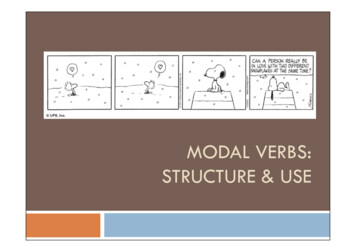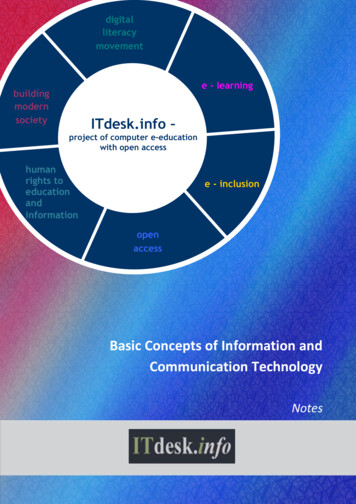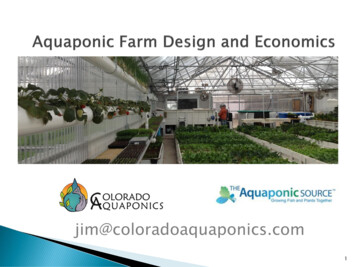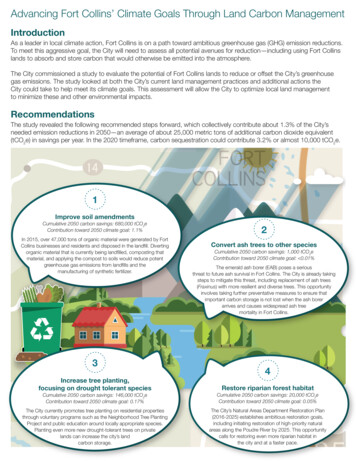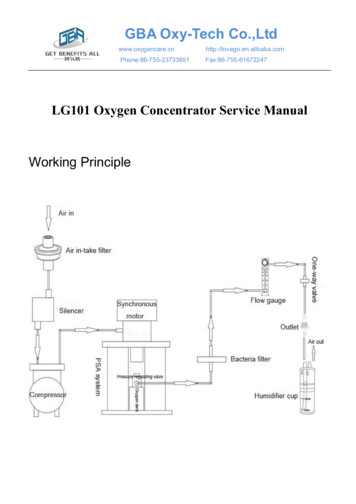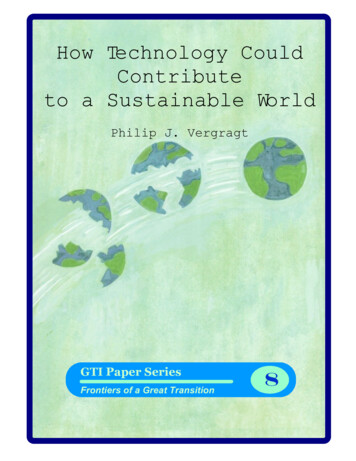
Transcription
How Technology CouldContributeto a Sustainable WorldPhilip J. VergragtGTI Paper SeriesFrontiers of a Great Transition128
Tellus Institute11 Arlington StreetBoston, MA 02116Phone: 1 617 2665400Email: info@tellus.orgTellus Web: http://www.tellus.orgGTI Web: http://www.gtinitiative.org Copyright 2006 by the Tellus InstituteSeries Editors: Orion Kriegman and Paul RaskinManuscript Editors: Faye Camardo, Loie Hayes, Pamela Pezzati, Orion StewartCover Image: Stephen Bernow and Devra EhrenbergPrinted on recycled paper
The Great Transition InitiativeGTI is a global network of engaged thinkers and thoughtful activists who are committed torigorously assessing and creatively imagining a great transition to a future of enrichedlives, human solidarity, and a healthy planet. GTI’s message of hope aims to counterresignation and pessimism, and help spark a citizens movement for carrying the transitionforward. This paper series elaborates the global challenge, future visions, and strategicdirections.GTI Paper SeriesFrontiers of a Great TransitionThe Global Moment and its Possibilities1.Great Transition: The Promise and Lure of the Times Ahead(Raskin, Banuri, Gallopín, Gutman, Hammond, Kates, Swart)Planetary civilization, global scenarios, and change strategies2.The Great Transition Today: A Report From the Future (Raskin)An optimistic vision of global society in the year 2084Institutional Transitions3.Global Politics and Institutions (Rajan)Principles and visions for a new globalism4.Visions of Regional Economies in a Great Transition World (Rosen and Schweickart)Reinventing economies for the twenty-first century5.Transforming the Corporation (White)Redesigning the corporation for social purpose6.Trading into the Future: Rounding the Corner to Sustainable Development (Halle)International trade in a sustainable and equitable world7.Security in the Great Transition (Knight)Imagining a transition to a world without war8.How Technology Could Contribute to a Sustainable World (Vergragt)Technological innovation and human choiceHuman and Environmental Dimensions9.Great Transition Values: Present Attitudes, Future Changes (Kates, Leiserowitz, Parris)Alignment and tension between contemporary values and a new global humanism10. The Role of Well-being in a Great Transition (Stutz)Improved quality-of-life as an attractor for dematerialized societies11. Feminist Praxis: Women’s Transnational and Place Based Struggles for Change (Harcourt)Lessons from women's movements for a Great Transition12. Sustainable Communities and the Great Transition (Goldstein)New frontiers for transforming cities13. Climate Change: Redemption through Crisis (Kartha)The climate challenge and paths to an equitable solution14. Resilience and Pluralism: Ecosystems and Society in a Great Transition (Lucas, Bennett)Human impacts on the biosphere and socio-ecological managementCrystallizing a Systems Shift15. Dawn of the Cosmopolitan: The Hope of a Global Citizens Movement (Kriegman)Prospects for a global movement and what it might look like16. World Lines: Pathways, Pivots and the Global Future (Raskin)Dynamics of global change: crisis, choice, and action
AuthorPhilip Vergragt is Senior Associate at the Tellus Institute, Visiting Scholar at MIT’sCenter for Technology, Policy and Industrial Development, and a Visiting ProfessorialFellow at the University of Manchester Business School. His current research focus is onsustainability transitions, with an emphasis on transport systems, energy, andconsumption patterns; visioning and back-casting; and social learning through boundedsocio-technical experiments. Previously, he taught Chemistry and Society at GroningenUniversity, was Deputy Director of the Dutch Government’s Program on SustainableTechnology Development, and was Professor of Technology Assessment at DelftUniversity of Technology. He has published many scientific articles, book chapters,conference papers, and co-authored two books. Vergragt holds a doctorate in Chemistryfrom Leiden University in the Netherlands.AcknowledgementsI thank my colleagues at Tellus Institute for stimulating and enlightening discussions andfeedback, and especially Orion Kriegman and Paul Raskin for close-reading, editing, andraising lots of interesting discussion points. I especially thank many members of GTITechnology working group (Emmanuel Asomba, Halina Brown, Ken Green, NicholasAshford, John Grin, Giok Ling Ooi, Philip Sutton, Morton Winston, Johan Schot, BrianMurphy, and Maurie Cohen) for helpful and stimulating comments in various stages ofwriting, and for encouragement. I apologize for not incorporating all suggestions; itwould have taken an entire book to incorporate all remarks. I am also especially gratefulto Sarah Burch, Tom Berkhout, Chrisna du Plessis, Louis Serra, Paulo Partidario, andNicole Dusyk, who each commented on the second draft, suggesting ways to strengthenthe essay, especially the final sections (how to get there). I hope this final version meetstheir expectations.
Table of ContentsIntroduction . 1The paradoxes of technological development. 1Aim of this essay. 1Meanings of “technology” . 2Societal consequences of technological developments. 3Decision-making on new technologies . 4Lay-out of this paper . 7Technological Developments and Future Studies. 7Two approaches . 7Technological forecasting and its pitfalls . 7Prospective and normative scenarios: a digression . 8Biotechnology and health technology . 9Nanotechnology . 10Information and Communication technologies; Artificial Intelligence . 11Interactions and mutual reinforcements . 12Appropriate technologies . 12Health care in Asian Societies . 13Summing up . 14Visions of Technology in a Sustainable Society. 14Introduction . 14Energy, health, and agriculture . 15Agoria . 17Ecodemia. 18Arcadia . 19To conclude. 20How Did We Get There? . 20Drivers of technological change . 20The "right" choices in technology development . 23Conclusion . 25References . 26List of FiguresFigure 1: The Linear Model of Technological Innovation .5Figure 2: Social Construction of Technology .6
How Technology Could Contribute to aSustainable WorldIntroductionThe paradoxes of technological developmentThe effects of technology underlie early twenty-first century global challenges. On theone hand, since the Enlightenment, technology, especially science-based technology, hasoffered the promise of a better world through the elimination of disease and materialimprovements to standards of living. On the other hand, resource extraction, emissions ofdangerous materials, and pollution of air, water, and soil have created conditions forunprecedented environmental catastrophe and have already caused irreversible damage tothe biosphere. While the future might promise a vast acceleration of technologicalinnovation, the scale and impact of environmental degradation may reflect this vastacceleration as well.A related painful paradox is that, despite the ongoing technological revolution, themajority of the world population still lives in abject poverty with inadequate food,housing, and energy, plagued by illnesses that could be easily cured if clean water andsimple drugs were made available. Fortunately a significant number of former“developing” countries are now on the threshold of development, helped by technologytransfer and technological innovations that have benefited large parts of their populations.Some countries, such as China, India, Korea, Taiwan, Singapore, and, to a certain extent,Brazil, have followed their own technological trajectories. However, for largepopulations in Africa, Asia, and Latin America the benefits of technology remain adream, even if new technologies like photovoltaic cells, cellular phones, and the Internetcould help them “leap-frog” towards the twenty-first century.The persisting contradictions between a better life created and supported by technologyfor the wealthy few, and increasing environmental degradation and persistent poverty forthe vast majority call for a deeper exploration and understanding of the nature oftechnology and its relationship to society, especially to a sustainable society. In thecontext of the effort to catalyze a Great Transition to a sustainable global society, inwhich deep changes in culture, values, consumption patterns, governance, business, andinstitutions are envisaged (Raskin et al., 2002), questions about the role of technologybecome even more pressing. For example, would a Great Transition society require anintensive use of technology to abate the environmental degradation of the ecosphere, ormight technology play a much more modest role in such a society? Would that societyessentially return to the time before the first industrial revolution when technologyoffered a limited, incremental extension of human capacity to transform nature? In eitherof these visions, we must ask how to imagine the development of technologically andeconomically underdeveloped countries.Aim of this essayThe aim of this essay is to envision a sustainable and equitable global society throughreflection on the role of technology during the transition to such a society and in that
How Technology Could Contribute to a Sustainable Worldsociety’s future. In a Great Transition society, technology will support and enhance a“good life” for all of its citizens, in both rich and presently poor countries, withoutcompromising the Earth’s ecosystem or the prospects of later generations. A good liferequires essentially that basic human needs are met and aspirations for freedom,belonging, and self-realization are fulfilled as much as possible (see Stutz, 2006). It doesnot necessarily mean the maximization of material production and consumption.Thus, we consider technological innovation in the context of the good life and how itcan be supported or threatened, depending on the way technological innovations areinfluenced and steered by human decisions and institutions.Meanings of “technology”The word “technology” encompasses essentially three meanings: tools and instrumentsto enhance human ability to shape nature and solve problems (such as a hammer andnail), knowledge of how to create things or how to solve problems (such as to brew beeror to make an atomic bomb), and culture (our understanding of the world, our valuesystems). Historically, the emergence of human civilization has been closely connected tothe development of tools for hunting, agriculture, irrigation and water management, andnavigation. In the second meaning, knowledge, technology becomes reflexive in thatunderstanding of how to make and use tools and instruments becomes encoded andtransmissible as technological knowledge and know-how. Related to this second meaningof technology is the development of modern scientific knowledge, based on empiricalobservations, hypotheses, and generalizations on the natural laws concerning the behaviorof materials and the living environment.In the third sense, culture, technology has permeated society to such an extent thatseparation between technology and culture is no longer meaningful. All human activities,like housing, nutrition, transportation, work, leisure, even art and imagination, becomeheavily enmeshed with technology. We “own” products of technology by a process of“cultural appropriation”, in which the use of technologies is learned, interpreted, andgiven meaning in everyday life. (Hard and Jamison, 2005). We are living in a “culturetechnique” in the sense that our deepest and most private knowledge and emotions arepermeated by technology.The transition from technology as tool use to knowledge began around the emergenceof the first industrial revolution more than two centuries ago. The transition to technologyas culture accelerated after the Second World War and is closely related to the rise ofinformation and communication technologies, biotechnology, computers, and theInternet.In contrast to technology, science is seen as an organized search for “truth” and“objective knowledge” about reality and the laws of nature. Science can be characterizedby a rigorous methodology exemplified by Popper’s claim that science is an unendingprocess of conjecture and falsification. In practice, the boundaries between modernscience and technology have become blurred; moreover, modern philosophy of sciencetreats scientific knowledge to a certain extent as “socially constructed” (see also thesection on decision-making and new technologies below). In this paper, we focusprimarily on technology, but science is relevant as one of the pillars of technologicalknowledge.2
VergragtIn the literature, technological innovation is generally understood as bringing a newproduct, process, or service successfully to the market, meaning that it can be sold for aprofit (Freeman, 1997). Technological innovation thus goes beyond invention, whichdepicts the elaboration and prototyping of a new technological principle; it is related todiffusion, which refers to the spread of new technology into the wider society. Of course,innovation is by no means identical with creating the physical conditions for a “good life”as defined above. Because of companies’ profit motives, as well as unintended andunforeseen consequences, the contribution can be both positive and negative. In a GreatTransition society, the definition of technological innovation will be changed (SeeSection 4, “How did we get there”).Societal consequences of technological developmentsSeventeenth-century thinkers such as Descartes and Bacon thought that science andtechnology unlocked the keys to mankind’s mastery over nature, which they saw assynonymous with human progress. Since the Enlightenment, the development of modernscience and technology has been associated with the triumph of reason and science oversuperstition and religion. Knowledge based on empirical observations and rationalthinking has been the basis on which technological innovation has thrived. Modernizationand modernity have been synonymous with technological innovation.The idea that science reflects reality or even absolute truth has been challenged in manyways, from critics of its reductionism to critics who emphasize that scientific facts are asmuch socially constructed as a reflection of natural laws (Latour and Woolgar, 1979). InThe Structure of Scientific Revolutions, in which he argued that theories and facts haveonly meaning within a dominant “paradigm”, Kuhn (1962) laid the groundwork forchallenging logical positivism. Latour and Woolgar (1979) followed by showing in ananthropological study of the modern scientific lab, how scientific facts are “sociallyconstructed” through interpretations by scientists of scientific measurements. Thus, themyth of the “objective scientific fact” was challenged and demystified. This work wasfollowed by the demystification of technology by the SCOT (Social Construction ofTechnology) theory (Pinch and Bijker, 1987; Bijker, 1995)The idea that technology could have unwanted or unintended consequences is alsorelatively new. Although the Luddities of the early nineteenth century smashed themachines that were seen as a threat to their employment, and the Romantics decried thedehumanizing march of industrialization, more widespread anxiety about and resistanceto technology did not emerge until the mid-1900s. The unprecedented destructionunleashed by the atomic bombing of Hiroshima and Nagasaki spurred many people toquestion the nature of the individual scientist’s ethical responsibility. To what extent isthe scientist accountable and responsible for unwanted and often unforeseenconsequences of his/her work? From that moment, the assumption of a self-evidentlinkage between societal progress and technological innovation has been questioned(Carson, 1962).Technology came under increasing scrutiny as a result of the use of Agent Orangeduring the Vietnam War and the persistence of dioxin contamination and birth defectsamong U.S. service members and the Vietnamese thereafter. Next came the protestsagainst nuclear energy and the possible health consequences of low doses of radiationfrom nuclear testing, uranium mining, and nuclear waste. Other environmental and health3
How Technology Could Contribute to a Sustainable Worldproblems followed: the consequences of air pollution, soil pollution, and water pollutionon health, safety, and the environment; the accumulation of DDT, heavy metals, andPCBs in the food chain and in the reproductive organs of animals and humans. With theincrease of biochemical knowledge—the possibilities of manipulation of the DNA ofmicrobes, plants, and animals—new hazards were created: man-made mutations andpathogens that created new risks for health, safety, and the environment. The nuclear,biological, and chemical arms race of course contributed to these anxieties.Early questions addressed not only the individual social and ethical responsibility ofscientists, but also the structural and even cultural connections between modern scienceand technology and the economic and political systems. President Eisenhower coined theterm “military-industrial complex” to describe the close relationship between thePentagon and the corporate defense industries and the Cold War ideology, which wasused to increase demand for new weapons systems and armaments—a perpetual wartimeeconomy. But the basic alliance between corporations and technology emerged muchearlier, in the late nineteenth century when the large chemical, electrical, and automobilecompanies were created, mainly in the USA and Germany.Technology and the military merged on a large scale in the Manhattan Project and inthe nuclear arms race after the Second World War. Since then, information,communication, biotechnology, energy technology, and medical technology have alldeveloped in “complexes” consisting of universities, large industrial firms and their R&Dlaboratories, small spin-off firms, and military research and development facilities.Financing is provided by a combination of military and business funding. At least in the“developed” world, citizens benefited from this unprecedented acceleration ofinnovation, which produced a surge of new products such as radio and color TV,microwave ovens and innovative cars, new medicines and medical technologies,computers and the Internet, and airplanes to take affluent consumers to holiday resorts.At the same time, social critics continued to voice concerns about the pace of changeand increasing fragmentation of modern life. For these critics, new products and servicescame at a price. Not only did environmental and health effects become problematic, butthe increasing rationalization of all aspects of life through technology also led to a deeperfeeling of alienation and dislocation. Jobs were lost to automation and to outsourcing ofproduction to low-wage countries. The globalization of production itself was madepossible by new transportation, information, and communication technologies. People inthe USA found themselves working harder and longer hours, and families suffered asoften both parents worked full-time to pay the mortgages on their houses. Many peoplefelt that they were no longer masters of their own lives, locked into a lifestyle determinedby a demand to keep pace with new technologies. A present example of such “lock-in” isthat of suburban residents being trapped in traffic jams and congestions due to urbansprawl. Decisions made on the individual level by consumers, in this case purchasingreadily available cars and suburban homes, often do not work out well when aggregatedto the societal level.Decision-making on new technologiesTechnologies co-evolve with societies (Saviotti, 2005); technological developmentsinfluence society and vice versa. The questions about who makes decisions about thedevelopment and direction of new technologies have seldom been asked and even less4
Vergragtoften answered. In academic circles in the 1960s and 1970s, questions were increasinglyvoiced about wanted and unwanted consequences, both foreseen and unforeseen, and thedirection and steering of new technologies in science, technology, and society studies,technological forecasting, technology assessment (Smits and Leyten, 1988), technologypolicy, and appropriate technology (Vergragt, 2003). Some of these studies were used bythe military and corporate planners to better forecast and assess the optimal directions offuture technologies; others were used to warn against possible catastrophes. A wellknown example is the 1972 Club of Rome forecast about a looming energy crisis and thepossibility of the exhaustion of fossil fuels.Apparently, the development of science and technology from tools to an encompassingculture obscured questions about their helmsmanship, especially the possibility ofdemocratic decision-making directing them. Such questions were obscured as well by thedominant philosophy and history of science and technology that emerged in the 1930s(empiricism and logical positivism), which posited that scientific invention is driven byinnate human curiosity and that scientific discovery eventually leads “automatically” totechnological application and commercial deployment. This approach, generally calledthe “linear model” of technological innovation, in which “science invents”, “technologyapplies”, and the “markets select”, suggests that some inexorable laws of nature, ratherthan human choices, are directing this endeavor (Fig. 1).Figure 1: The linear model of technological innovationscience inventstechnology appliesmarkets selectThe linear model, also called “technological determinism”, is no longer supported bymany academics, but is still widely believed in general society. Research into theprocesses of scientific and technological discovery has shown that the linear model is notvalid, disguising the role of human choice and values in shaping technology, as well asthe social and economic interests guiding scientific inventions and technologicalinnovations. It has been replaced by models like Social Construction of Technology(SCOT) (Pinch and Bijker, 1987; Bijker 1995) and Actor Network Theory (Callon, 1986;1987). These theories include social actors, problem definitions (Vergragt, 1988), andsocial networks. For example, in the SCOT theory, technological innovation is steered bythe meaning that “relevant social groups” give to a technological artifact, generatingproblem definitions that lead in turn to adjusted technological artifacts, a process highlycontingent on the particular context (Bijker, 1995; see Fig. 2).5
How Technology Could Contribute to a Sustainable WorldFigure 2: Social Construction of nicalartifactRevisedtechnicalartifactA technical artifact creates problems for several “relevant social groups”, which results in one or moreproblem definitions. These problem definitions lead to a revised technical artifact. The process is highlycontingent on contextual factors (after Bijker, 1995).Because of persistent broad acceptance in society of the myth of the linear model, thequestion of democratically determined guidance of science and technology seems like anoxymoron in the minds of most, even well-educated, citizens. Even when the linearmodel is understood to be false, a second myth holds that market forces are so strong thatdemocratic decision-making about science and technology is unthinkable in a marketeconomy (and, of course, science and technology in a totalitarian society are hamperedby limits on the free flow of information). Research has demonstrated that defenseinterests in most market economies dominate the research community to such a degreethat, in a “free society”, “market forces” do not determine the development of science andtechnology. Even one of the most “democratic” developments of the late twentiethcentury, the Internet, was originally designed and developed by DARPA, the Pentagon’smilitary research establishment.A third myth is “technological fix” thinking, which is the belief that technical meansalone can solve most problems, including the unanticipated consequences oftechnological innovation itself. Examples are the belief that the problem of hunger can besolved by biotechnology or that health problems can be solved by more drugs (instead ofimproving water and sanitation). Other examples include the belief in hydrogen to solveenergy problems (Vergragt, 2006) or carbon capture and storage as a solution to theclimate problem. Related are the ideas that terrorism can be solved by a technological“war” or by technical safety and vigilance measures.Each of those myths obscures seeing the possibilities of democratic decision-makingregarding technology. Of course, to see the possibilities is not to claim that democratic6
Vergragtdecision-making about technology would be easy. Indeed, there are many inherentproblems: science and technology are difficult to understand for most people (LokaInstitute, 2006), the consequences of decisions are hard to foresee, and scientificcommunities have their own systems of quality control that should not be criticized orsuperseded. On the other hand, it certainly makes a difference if society directs funding tothe development of renewable energy rather than nuclear energy, or to eradicating theworld’s most prominent diseases, such as malaria and tuberculosis, rather than drugs forprosperity diseases and high-technology medical equipment. It also would make adifference if we could change the laws and the institutions regarding accessibility ofscientific information—the patenting laws—that regulate intellectual property and therelated profits.Lay-out of this paperSo, how could technology (and what technologies could) contribute to a sustainablesociety as envisioned in the Great Transition scenario? In order to explore this question,we will develop a broad-brush picture of future technological developments and some oftheir societal consequences (Section 2). We then will develop a vision of a GreatTransition world with a focus on technological aspects (Section 3). Finally, we look backfrom the future and explore events, pathways, mechanisms, and choices that contributedto the realization of that vision (Section 4).Technological Developments and Future StudiesTwo approachesIn this section, we follow two lines of thought. The first considers some of thedominant developments in so-called high-tech: information and communicationtechnologies, biotechnology and health technology, and new materials andnanotechnology. The second line explores the so-called “alternative” technologicaldevelopments, such as appropriate technology and traditional health and medicine.Although these latter technologies have been developed from a different perspective thanmodern industrial technology, they are relevant for developing a more holistic view ofscience and the sustainability challenge.Technological forecasting and its pitfallsForecasting the development of innovative, especially entirely new technologies is, ofcourse, very difficult. The history of past efforts is full of false predictions anddisappointments. Some of the most impressive technological developments, like thepersonal computer and the Internet, were not anticipated
Trading into the Future: Rounding the Corner to Sustainable Development (Halle) International trade in a sustainable and equitable world 7. Security in the Great Transition (Knight) Imagining a transition to a world without war 8. How Technology Could Contribute to a Sustainable W

